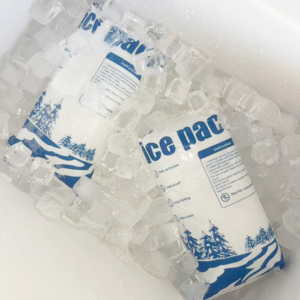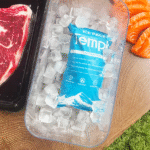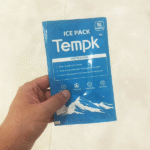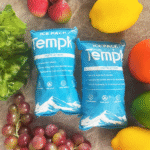Lors de l'expédition de marchandises sensibles à la température, dry ice bags are essential to maintaining ultra-low temperatures throughout transit. Whether you’re handling biological samples, médicaments, ou aliments surgelés, compréhension how to pack and use dry ice bags correctly is key to ensuring safety, efficacité, et le respect des réglementations évolutives. This guide will cover the step-by-step process for using dry ice bags in 2025, focusing on packing, sécurité, et bonnes pratiques.

What Are Dry Ice Bags and Why Are They Crucial for Shipping?
UN sac à glace sec is an insulated, vented pouch specifically designed to hold dry ice in a secure and controlled manner. These bags are essential for maintaining subzero temperatures (below -78.5°C or -109.3°F), ideal for shipping items that need to stay frozen, tel que échantillons biologiques, médicaments, et aliments surgelés. Contrairement aux packs de glace traditionnels, dry ice sublimates directly into gas without leaving moisture behind, which prevents water damage to products.
Using dry ice bags ensures that your goods remain at the required low temperatures throughout the shipment. De plus, the venting mechanism built into the bags allows the carbon dioxide gas from the sublimating dry ice to escape, preventing pressure buildup and ensuring safety.
Pourquoi ça compte:
Dry ice bags are critical in cold chain logistics because they provide a controlled environment that preserves product integrity, maintains regulatory compliance, and prevents the loss of product efficacy or spoilage during transit.
How to Pack Dry Ice Safely in a Bag for Shipment?
Step-by-Step Packing Guide
-
Choose the Correct Dry Ice Bag
Sélectionnez un sac de glace carbonique ventilé of appropriate size for your shipment. Ensure that there is enough space in the bag for gas expansion as dry ice sublimates. -
Porter un équipement de protection
Toujours porter gants isolés when handling dry ice to avoid frostbite or burns. Handle the dry ice carefully to prevent injury. -
Add the Dry Ice
Place the dry ice inside the bag, ensuring it is securely packed but not overpacked, allowing space for gas to escape through the bag’s vents. -
Sceller le sac
Seal the bag but leave a small opening, or use a venting plug to allow dioxyde de carbone (Co₂) to escape safely. Never seal dry ice bags completely as this can cause dangerous pressure buildup. -
Étiquetez le colis
Ensure that the bag is correctement étiqueté avec Et 1845 (Glace sèche), the net weight of the dry ice in kilograms, and any other required hazard markings. This is crucial for regulatory compliance during transit.
What Products Require Dry Ice Bags for Shipping?
Ideal Products for Dry Ice Use
Dry ice bags are typically used for shipping products that require extremely low temperatures throughout the transport process. Ceux-ci incluent:
-
Médicaments: Vaccins, temperature-sensitive drugs, et biologique that must remain frozen.
-
Aliments surgelés: Fruit de mer, viande, et glace, which need to stay at sub-zero temperatures.
-
Échantillons biologiques: Blood samples, cultures de tissus, et research specimens that require constant freezing.
Why Dry Ice Is Superior for These Products
Dry ice maintains temperatures far below what standard ice can offer, keeping goods frozen without the risk of water damage. De plus, since dry ice sublimes into gas, there’s no melting water to cause product contamination or packaging damage.
Safety Regulations for Using Dry Ice Bags in 2025
Glace sèche, classified as a bien dangereux, doit se conformer Voici pi 954 et 49 CFR 173.217 regulations for air, mer, and ground transport. These guidelines are designed to minimize hazards related to dioxyde de carbone (Co₂) gaz. When using dry ice bags, it’s critical to:
-
Mark Properly: Label the shipment with Et 1845 (Glace sèche) et le poids net de glace carbonique en kilogrammes.
-
Aérer le sac: Ensure the dry ice bag is vented to allow the sublimated CO₂ to escape. Cela empêche l'accumulation de pression.
-
Follow Carrier Guidelines: Confirm the maximum weight limits of dry ice allowed by your carrier, as some air carriers limit dry ice per package.
Conseil: Always check with your carrier’s specific dry ice transportation guidelines. Some carriers like FedEx et Hauts have updated their dry ice transport policies in 2025 to accommodate the latest safety standards.
Choosing the Right Dry Ice Bag for Your Needs
Bag Types and Features
| Type de sac | Mieux pour | Caractéristiques clés | Ce que cela signifie pour vous |
|---|---|---|---|
| Sacs standards | Petites expéditions, standard shipping | Light insulation, basic venting | Ideal for short routes and small shipments |
| Sacs personnalisés | Large or complex shipments | Heavy-duty insulation, coutures renforcées, specialized venting | Better insulation and more durable for long-distance shipments |
| Medical-Grade Bags | Biologique, médicaments | Haute isolation, regulatory approval | Provides enhanced safety and reliability for sensitive products |
How to Choose the Right One
Select the bag that suits your taille de l'expédition, distance, et température ambiante. Custom bags are ideal for shipments with fragile ou valuable items like échantillons biologiques that require extra protection. Standard bags work well for smaller shipments where temperature fluctuations are less of a concern.
2025 Tendances et innovations dans le transport de glace carbonique
Tendances clés
Comme le logistique de la chaîne du froid industry evolves, several innovations are shaping the future of dry ice use:
-
Surveillance intelligente: Intégration de Capteurs IoT to track température et CO₂ levels pendant le transport. This provides real-time data to ensure compliance and safety.
-
Pratiques durables: Increasing use of Co₂ recyclé dans la production de glace carbonique, réduire l'empreinte carbone.
-
Matériaux d'isolation avancée: Des matériaux comme panneaux à vide et aérogels are enhancing dry ice efficiency, extending the hold times and reducing sublimation rates.
Impact sur vous: These trends offer better product preservation, reduced environmental impact, et greater regulatory compliance, making your shipping process more efficient and sustainable.
Common Mistakes to Avoid When Using Dry Ice Bags
| Erreur | Conséquence | Solution |
|---|---|---|
| Fermer hermétiquement le refroidisseur | Pressure buildup, potential rupture | Leave vent holes or tape the lid loosely |
| Contact direct avec de la glace sèche | Packaging film becomes brittle and tears | Use a spacer between the dry ice and packaging |
| Underfilled insulation gaps | Sublimation plus rapide, uneven cooling | Fill voids with paper or air pillows |
Pour la pointe: Ensure that dry ice is placed au-dessus de le produit, Alors que l'air froid coule, ensuring even cooling of the goods.
Conclusion et recommandations
Proper use of sacs à glace sec is essential for sûr, efficace, et conforme shipping of temperature-sensitive goods. By following the latest guidelines, packing correctly, and using the appropriate type of bag for your needs, you can ensure your products remain at the desired temperature throughout the shipping process.
Étapes suivantes:
-
Choose the Right Dry Ice Bag: Assess your shipment requirements and select the appropriate bag type (standard, coutume, or medical-grade).
-
Surveiller la température pendant le transit: Pensez à utiliser surveillance intelligente systems to track temperature and ensure compliance.
-
Adhere to Regulations: Suivez toujours Iata et 49 CFR guidelines for labeling, emballage, et ventilation.
Contacter le tempk today for personalized advice and the best dry ice solutions for your business.
À propos du tempk
À Rotation, we specialize in providing high-quality dry ice bags and cold chain solutions to ensure the safe, efficace, and compliant transport of temperature-sensitive goods. Our products help businesses maintain product integrity while complying with the latest 2025 règlements.
Prêt à optimiser votre logistique de chaîne froide? Contact Rotation for expert advice and customized solutions tailored to your needs.























